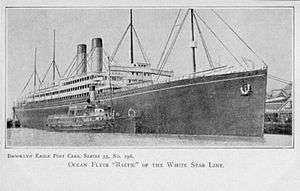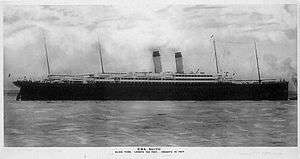RMS Baltic (1903)
RMS Baltic was an ocean liner of the White Star Line that sailed between 1904 and 1933. At 23,876 gross tons, she was the world's largest ship until 1905. She was the third of a quartet of ships, all measuring over 20,000 gross tons, dubbed The Big Four (the other three being RMS Celtic, Cedric, and Adriatic).
 Postcard picture of Baltic | |
| History | |
|---|---|
| Owner: | White Star Line |
| Operator: | White Star Line |
| Port of registry: | Liverpool |
| Route: | Liverpool to New York City |
| Builder: | Harland and Wolff, Belfast, UK |
| Yard number: | 352 |
| Launched: | 21 November 1903 |
| Completed: | 23 June 1904 |
| Maiden voyage: | 29 June 1904 |
| In service: | 1904–1933 |
| Fate: | Scrapped in Osaka, Japan |
| General characteristics | |
| Tonnage: | 23,876 GT |
| Length: | 729 ft (222.2 m) |
| Beam: | 75.6 ft (23.0 m) |
| Propulsion: | Two four-cylinder quadruple expansion engines powering two propellers |
| Speed: | 16 knots (30 km/h; 18 mph) |
| Capacity: | 2,875 passengers |
Early service
She was launched on 21 November 1903 by Harland and Wolff at Belfast and sailed from Liverpool on her maiden voyage to New York on 29 June 1904 with Captain Edward Smith in command.
On 23 January 1909 (commanded by J. B. Ranson), she rescued survivors of the collision in fog between the White Star Line's RMS Republic and the SS Florida off the north eastern coast of the United States, after which Republic sank.
On 30 June 1910 Baltic was in collision with the German steamer Standard. Baltic was holed above the waterline while Standard's bow was badly damaged.[1] On 14 April 1912, Baltic sent an ice warning message to the RMS Titanic:
"Greek steamer Athenia reports passing icebergs and large quantities of field ice today in latitude 41° 51' N, longitude 49° 52' W. Wish you and Titanic all success. Commander."[2]
Participation in World War I
When World War I started in 1914, Baltic assisted in the evacuation of Americans from Europe and hauling war materials from the US to Britain. Passenger numbers shrank quickly with fears of submarines, which were sighted by the RMS Baltic on several occasions. On 1 January 1916 she arrived in New York with $35,000,000 in gold bullion. Later in 1916 she was used in transporting the Canadian Expeditionary Force from Halifax to Britain.[3]

Baltic was the vessel used to deliver Major General John J. Pershing and his staff to England. On 9 June 1917, the War Department released its first communique revealing the General's arrival in England:
"Baltic Carried Pershing Over. Londoners Preparing to Entertain American Soldiers. 10 U.S. Airmen in France. Pershing's Personal Staff and Other Members of General Staff Number 67 Officers and Are Accompanied by a Squad of 50 Privates and a Large Civilian Clerical Force- Pershing Anxious to Get into Harness. London, June 9.- Headed by Major General John J. Pershing, its commander, the first representation of the American army that is to enter the European war disembarked at a British port after an uneventful voyage of 10 days on board the White Star liner Baltic. The party was received with full military honors and immediately entrained for London, where it arrived and was welcomed by the Earl of Derby, the minister of war; Viscount French commander of the British forces, and the American officials..."[4]

Post-war years
In 1923, a young Isaac Asimov emigrated with his family to the United States aboard RMS Baltic.[5]
She was also involved in a rescue on 6 December 1929, when she assisted the sinking schooner Northern Light. Baltic became a regular at the newly created Canadian immigration terminal Pier 21 when it opened in 1928. Baltic made 18 voyages to Pier 21 including the ship's final voyage in September 1932.[6]
On 17 February 1933, she sailed for Osaka, Japan where she was scrapped.
References
Notes
- "The Fleets of the Mail Lines: Coincidences in Shipping Affairs". The Marine Engineer and Naval Architect. Vol. 33. September 1910. p. 40.
- S/S Baltic (2), White Star Line
- "Baltic Carried Pershing Over". Dunkirk Evening Observer (9 June 1917), p. 3, col. 2
- Asimov, Isaac (1979) In Memory Yet Green, pp. 40–41. Avon.
- "Ship Arrivals Database", Canadian Museum of Immigration at Pier 21
Bibliography
- Chirnside, Mark (2016). The 'Big Four' of the White Star Fleet: Celtic, Cedric, Baltic & Adriatic. Stroud, Gloucestershire: The History Press. ISBN 9780750965972.
External links
- http://www.greatships.net/baltic.html
- http://www.shorpy.com/White_Star_Line_piers_New_York_1904 (RMS Baltic, White Star Line Pier, New York, 1904)
- http://www.norwayheritage.com/p_ship.asp?sh=balt2